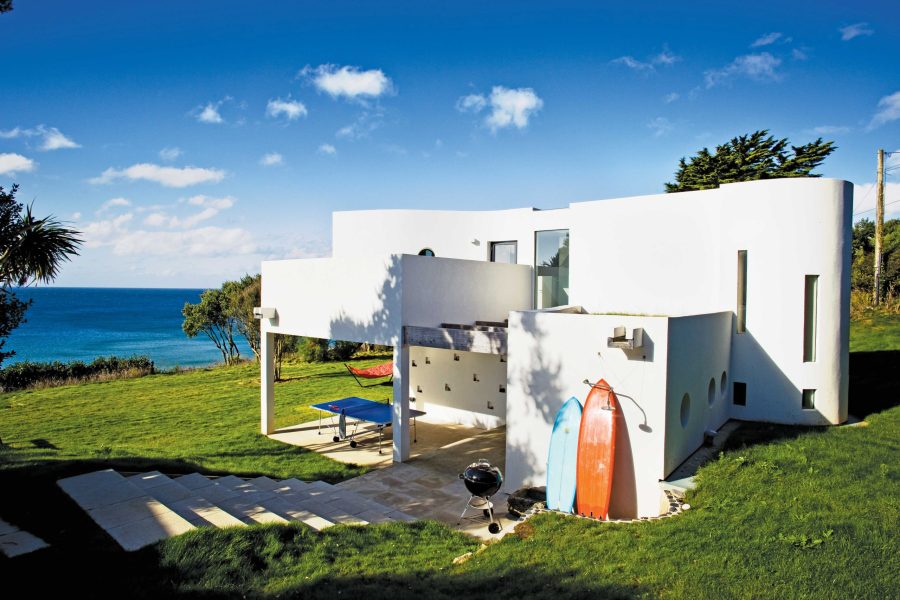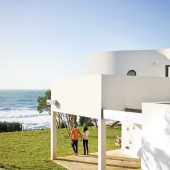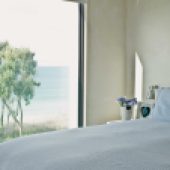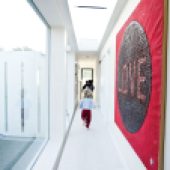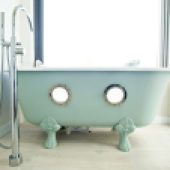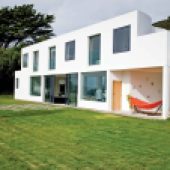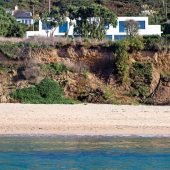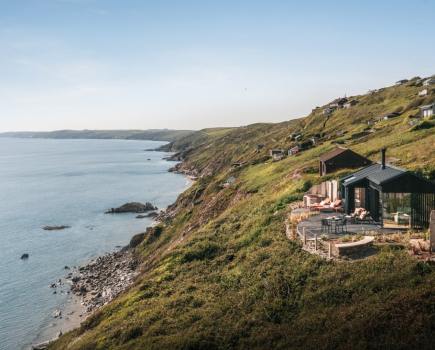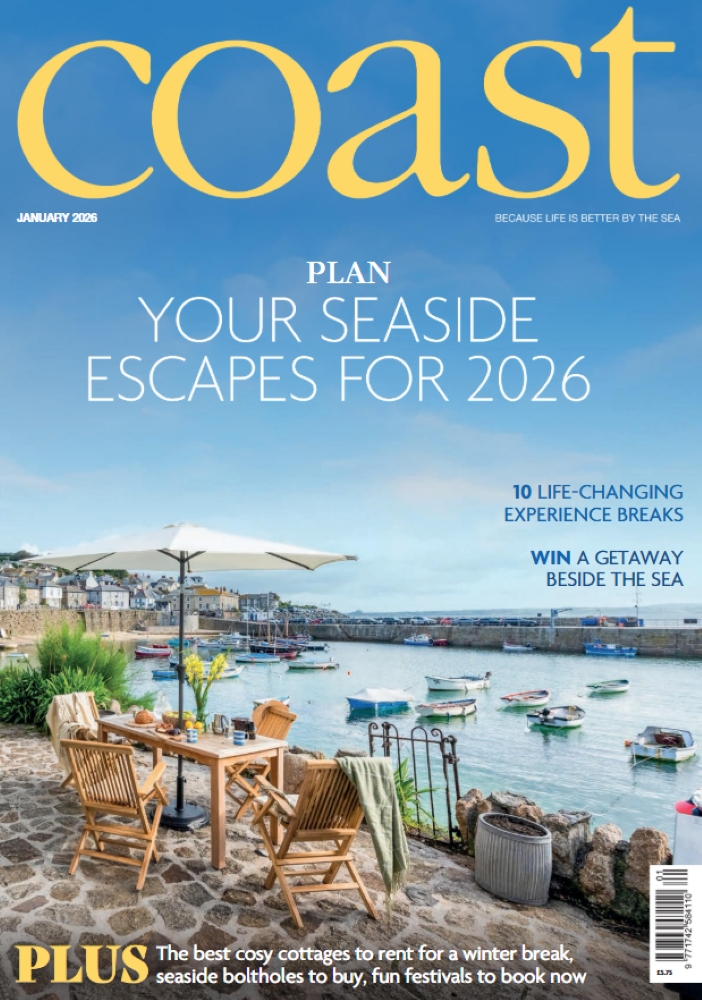Enchanted by the intense light and spectacular views of the Cornish coast, architect Alex Michaelis built his family a pristine, contemporary beach house that’s tailor-made for a chilled-out life by the sea. Words: Alice Westgate. Photographs: Greg Martin
The funny thing about Little Cottage is that it is neither little nor a cottage. It is a big, bold ultra-modernist eco home a stone’s throw from the sea. The name comes from the small, tumbledown chalet that once stood on the site – a property that London-based architect Alex Michaelis stumbled on by chance one day in 2009.
‘I was building a house for a client in Cornwall when a friend showed me the estate agent’s details,’ he recalls. ‘I had a couple of hours to kill after a meeting, so I arranged a viewing. I had never seen a site like it – it was so open and had the most amazing view.’
The house occupied the last plot at Praa Sands, which sits between Helston and Penzance, so the beach in front of the house was unusually quiet; stretching into the distance was mile upon mile of totally unspoilt coastline.‘I wasn’t even thinking of buying a property in Cornwall, but decided we should live there on the spot,’ adds Alex.
The garden was wildly overgrown, and the cottage, though charming, was in a poor state of repair. ‘It was very sweet and I did think about working with and adapting the original structure, but when a survey showed that the bones of the house were completely rotten and would have to be rebuilt, it made sense to start again from scratch.’
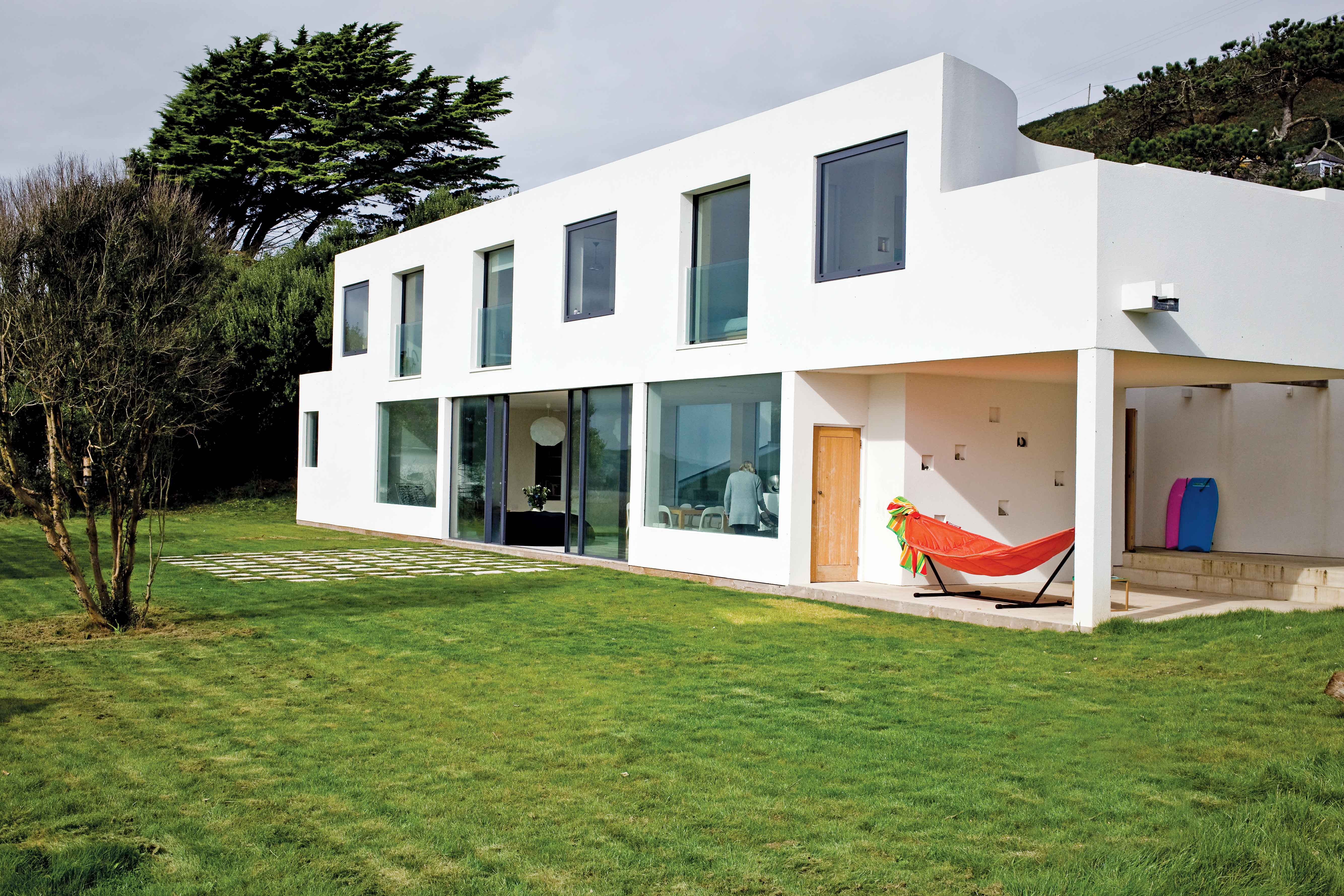
FREEDOM TO DREAM
Dreaming up a new home was a rich opportunity for Alex, even though he works on some jaw-droppingly beautiful projects in his role as partner at Michaelis Boyd, a prestigious international architectural practice in London.
‘The freedom we had with this scheme was a real gift,’ he admits. ‘The planners placed no restrictions, though they did ask me to scale down the size of my initial idea. Overall they were incredibly positive, and it was refreshing that they were so keen to support a contemporary building like this.’
The central tenet of Alex’s design was to make as much of the seafront view as possible, and he achieved this by designing the house from the outside in. ‘The main living room, plus all the bedrooms and bathrooms, face due south, towards the sea,’ he says. ‘The light and views were so incredible that the house just had to revolve around them.’
The rest of the building followed very naturally from this and includes a huge ground-floor kitchen and living space that opens on to the garden – and to the sea beyond – via vast sliding glass doors. ‘The outer skin is just holding it all together, really,’ says Alex. ‘It is a very easy building to read.’
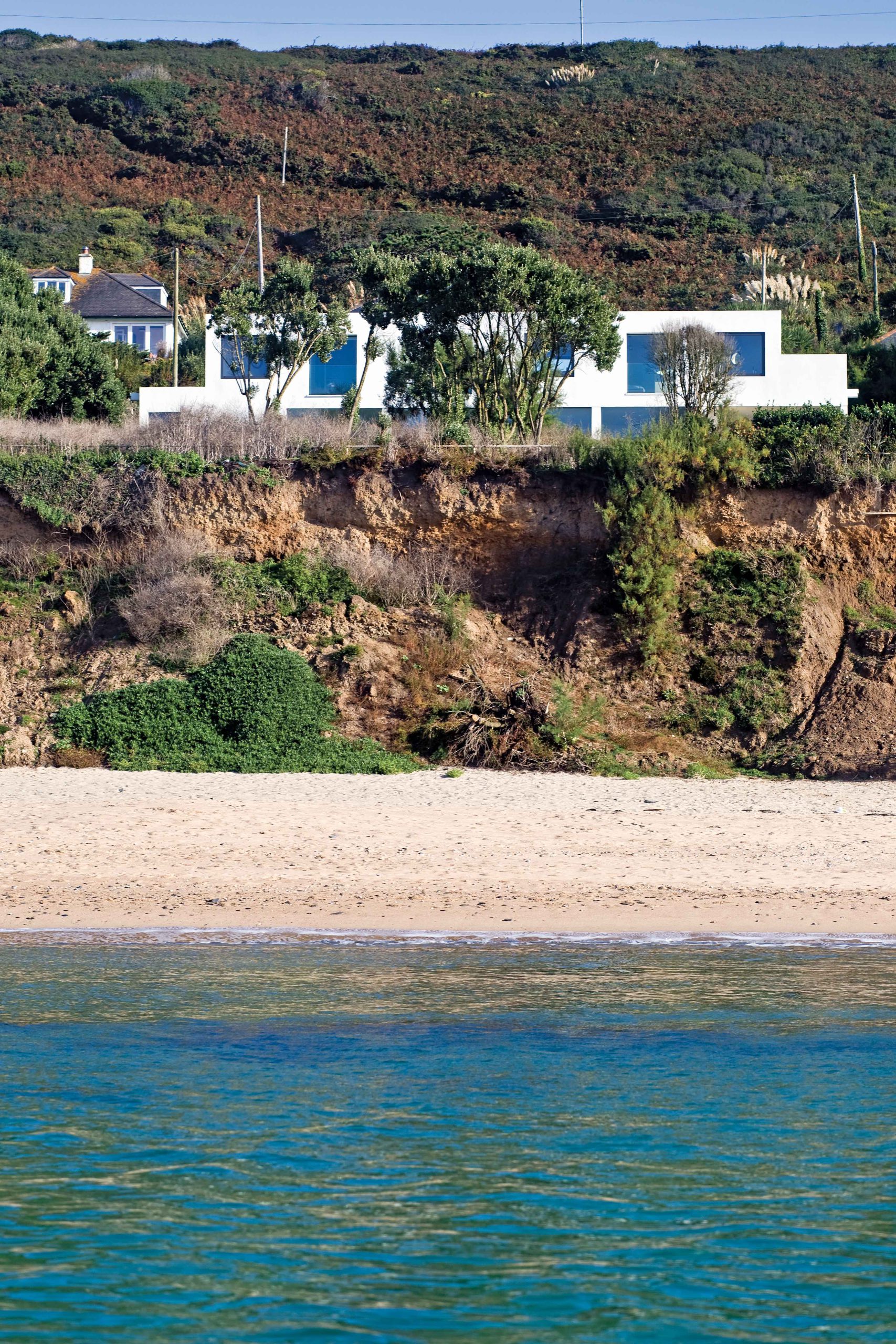
A parallel simplicity comes from the materials Alex used throughout the interior, where bleached wood floors and unpainted milky-coloured plaster walls ensure that the view through the windows is always the star of the show. ‘This pale plaster is the French equivalent of the pink stuff you usually get here,’ says Alex. ‘At first it appears to be white, but there is an incredible depth to it.’
This plaster looks particularly mouth-watering in the helix-shaped staircase. ‘It is designed to be like a shell, a nod to the seaside setting,’ says Alex. ‘The stairs start off quite wide but each step gets increasingly narrow – and the walls increasingly thick – as you rise to the top. It sounds fiendishly complicated architecturally but, amazingly, it wasn’t a problem to construct and everyone including the builders bought into it from the start.’
ART-DECO INFLUENCES
The contours of the stairwell are clearly visible on the exterior of the building, which is finished in white-washed render: ‘Curves are very common in Art-Deco buildings in Cornwall, so there are echoes of that tradition in this house,’ says Alex.
From above, however, the building is invisible amid the surrounding landscape because its flat roof is planted with grass; this, in time, will become mixed with whatever indigenous plants fancy making it their home: ‘Like Le Corbusier said, you should always give the land that is occupied by a building back to the natural world,’ explains Alex.
The living roof is just one of many eco-friendly features at Little Cottage. Warmth comes via a ground-source heat pump and a wood-burning stove, while solar panels give hot water. Acres of glass provide masses of thermal gain, and vertical conduits encourage passive ventilation.
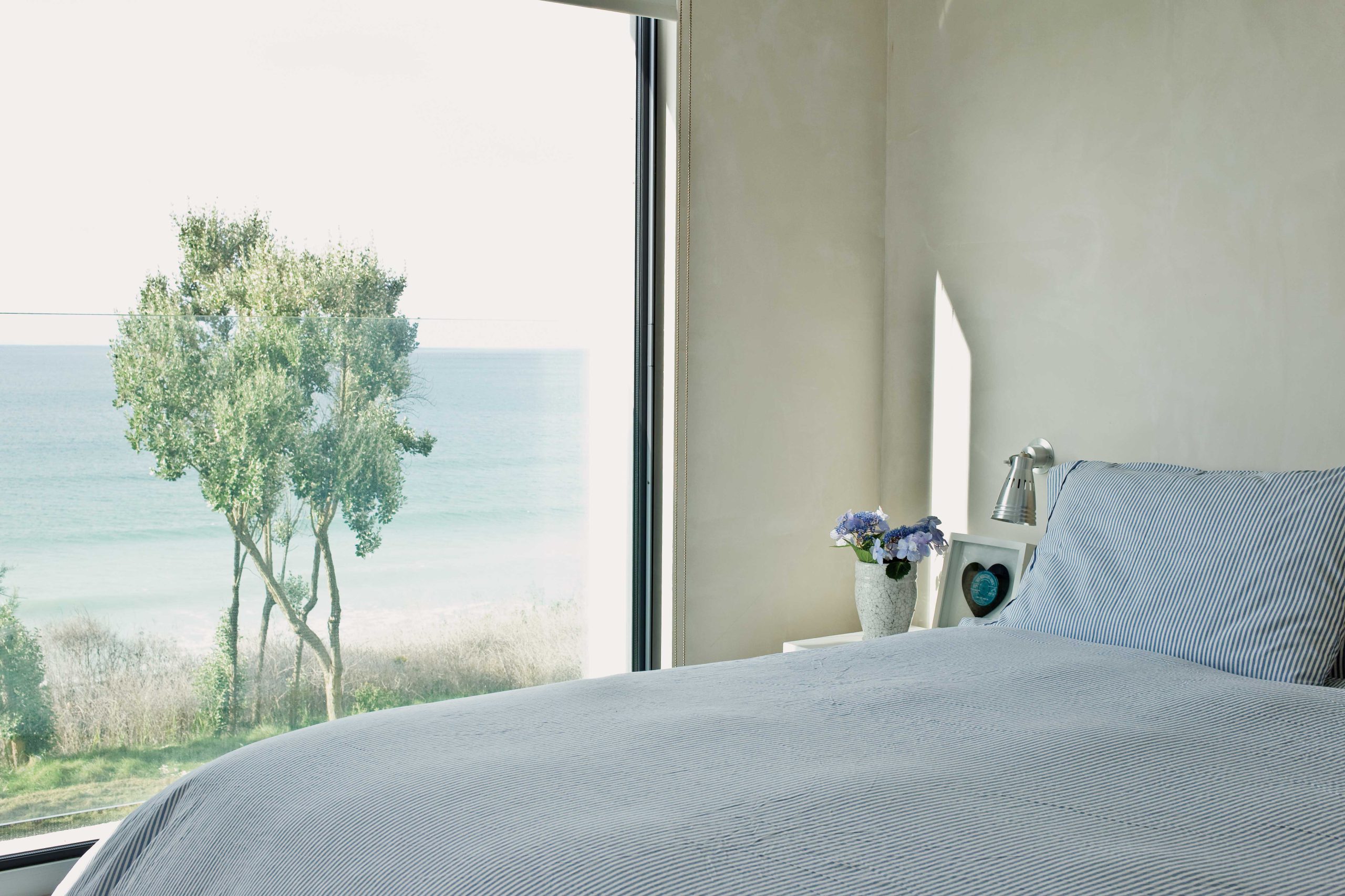
All this – plus the intoxicating sound of the surf – draws Alex and his partner Susanna Bell to Praa Sands from London at every available opportunity. Between them, the couple have seven children: Zac, Kit, Olivia, Orlando, Ro, Samb, and Raffe. The family are always accompanied by their black Labrador, Seal.
‘We have everything we need here, from walking boots to wetsuits, so we can just jump into the car and escape when we feel the need,’ says Alex. ‘We love to go surfing, swimming and rock-jumping in all conditions; then we’ll buy fish from Porthleven and have a barbecue in the garden, or a pizza cooked in our Chadwick oven, as the sun goes down.’
The Little Cottage that once stood here is a distant memory – all that remains is a small wooden gate, a lean-to shed and the name. But, crucially, the house that has replaced it will perpetuate the precious spirit of this place for many years to come.
The Little Cottage is available to rent through airbnb.co.uk
Coast-inspired design features at Little Cottage
• French plaster walls and limed floors create a sun-bleached look.
• Self-cleaning render on the exterior, so that the walls are washed by the rain and the sea.
• Porthole windows throughout the property.
• An outdoor shower and huge utility room, complete with wetsuit drying area, designed for post-beach practicality.
• A shell-like staircase that rises in a perfect spiral.
• A living roof that blends the building with the surrounding meadows and dunes.
• Versatile, portable furniture that is happy indoors or out.
• Jewel-like mosaic tiles in the bathrooms, all in pearlescent shades of blue and green.
• A surfboard-shaped mat set into the floor beside the front door.
Enchanted by the intense light and spectacular views of the Cornish coast, architect Alex Michaelis built his family a pristine, contemporary beach house that’s tailor-made for a chilled-out life by the sea. Words: Alice Westgate. Photographs: Greg Martin
The funny thing about Little Cottage is that it is neither little nor a cottage. It is a big, bold ultra-modernist eco home a stone’s throw from the sea. The name comes from the small, tumbledown chalet that once stood on the site – a property that London-based architect Alex Michaelis stumbled on by chance one day in 2009.
‘I was building a house for a client in Cornwall when a friend showed me the estate agent’s details,’ he recalls. ‘I had a couple of hours to kill after a meeting, so I arranged a viewing. I had never seen a site like it – it was so open and had the most amazing view.’
The house occupied the last plot at Praa Sands, which sits between Helston and Penzance, so the beach in front of the house was unusually quiet; stretching into the distance was mile upon mile of totally unspoilt coastline.‘I wasn’t even thinking of buying a property in Cornwall, but decided we should live there on the spot,’ adds Alex.
The garden was wildly overgrown, and the cottage, though charming, was in a poor state of repair. ‘It was very sweet and I did think about working with and adapting the original structure, but when a survey showed that the bones of the house were completely rotten and would have to be rebuilt, it made sense to start again from scratch.’

FREEDOM TO DREAM
Dreaming up a new home was a rich opportunity for Alex, even though he works on some jaw-droppingly beautiful projects in his role as partner at Michaelis Boyd, a prestigious international architectural practice in London.
‘The freedom we had with this scheme was a real gift,’ he admits. ‘The planners placed no restrictions, though they did ask me to scale down the size of my initial idea. Overall they were incredibly positive, and it was refreshing that they were so keen to support a contemporary building like this.’
The central tenet of Alex’s design was to make as much of the seafront view as possible, and he achieved this by designing the house from the outside in. ‘The main living room, plus all the bedrooms and bathrooms, face due south, towards the sea,’ he says. ‘The light and views were so incredible that the house just had to revolve around them.’
The rest of the building followed very naturally from this and includes a huge ground-floor kitchen and living space that opens on to the garden – and to the sea beyond – via vast sliding glass doors. ‘The outer skin is just holding it all together, really,’ says Alex. ‘It is a very easy building to read.’

A parallel simplicity comes from the materials Alex used throughout the interior, where bleached wood floors and unpainted milky-coloured plaster walls ensure that the view through the windows is always the star of the show. ‘This pale plaster is the French equivalent of the pink stuff you usually get here,’ says Alex. ‘At first it appears to be white, but there is an incredible depth to it.’
This plaster looks particularly mouth-watering in the helix-shaped staircase. ‘It is designed to be like a shell, a nod to the seaside setting,’ says Alex. ‘The stairs start off quite wide but each step gets increasingly narrow – and the walls increasingly thick – as you rise to the top. It sounds fiendishly complicated architecturally but, amazingly, it wasn’t a problem to construct and everyone including the builders bought into it from the start.’
ART-DECO INFLUENCES
The contours of the stairwell are clearly visible on the exterior of the building, which is finished in white-washed render: ‘Curves are very common in Art-Deco buildings in Cornwall, so there are echoes of that tradition in this house,’ says Alex.
From above, however, the building is invisible amid the surrounding landscape because its flat roof is planted with grass; this, in time, will become mixed with whatever indigenous plants fancy making it their home: ‘Like Le Corbusier said, you should always give the land that is occupied by a building back to the natural world,’ explains Alex.
The living roof is just one of many eco-friendly features at Little Cottage. Warmth comes via a ground-source heat pump and a wood-burning stove, while solar panels give hot water. Acres of glass provide masses of thermal gain, and vertical conduits encourage passive ventilation.

All this – plus the intoxicating sound of the surf – draws Alex and his partner Susanna Bell to Praa Sands from London at every available opportunity. Between them, the couple have seven children: Zac, Kit, Olivia, Orlando, Ro, Samb, and Raffe. The family are always accompanied by their black Labrador, Seal.
‘We have everything we need here, from walking boots to wetsuits, so we can just jump into the car and escape when we feel the need,’ says Alex. ‘We love to go surfing, swimming and rock-jumping in all conditions; then we’ll buy fish from Porthleven and have a barbecue in the garden, or a pizza cooked in our Chadwick oven, as the sun goes down.’
The Little Cottage that once stood here is a distant memory – all that remains is a small wooden gate, a lean-to shed and the name. But, crucially, the house that has replaced it will perpetuate the precious spirit of this place for many years to come.
The Little Cottage is available to rent through airbnb.co.uk
Coast-inspired design features at Little Cottage
• French plaster walls and limed floors create a sun-bleached look.
• Self-cleaning render on the exterior, so that the walls are washed by the rain and the sea.
• Porthole windows throughout the property.
• An outdoor shower and huge utility room, complete with wetsuit drying area, designed for post-beach practicality.
• A shell-like staircase that rises in a perfect spiral.
• A living roof that blends the building with the surrounding meadows and dunes.
• Versatile, portable furniture that is happy indoors or out.
• Jewel-like mosaic tiles in the bathrooms, all in pearlescent shades of blue and green.
• A surfboard-shaped mat set into the floor beside the front door.

